Detailed Analysis of Accounting and Financial Reporting Report
VerifiedAdded on 2021/06/18
|12
|3636
|211
Report
AI Summary
This report provides a detailed analysis of accounting and financial reporting practices. It begins with an introduction to financial statements and their importance, emphasizing their use by both management and third-party investors. Part A examines the preparation of financial statements, adhering to standards like AASB 101 and 108, ensuring fair representation and compliance with IFRS. Part B delves into accounting disclosures, discussing their significance as highlighted by Warren Buffett, and addresses the issue of disclosure overload. Part C focuses on financial instruments, differentiating between equity, debt, and foreign exchange instruments. The report stresses the importance of accurate and transparent financial reporting for informed decision-making by stakeholders.
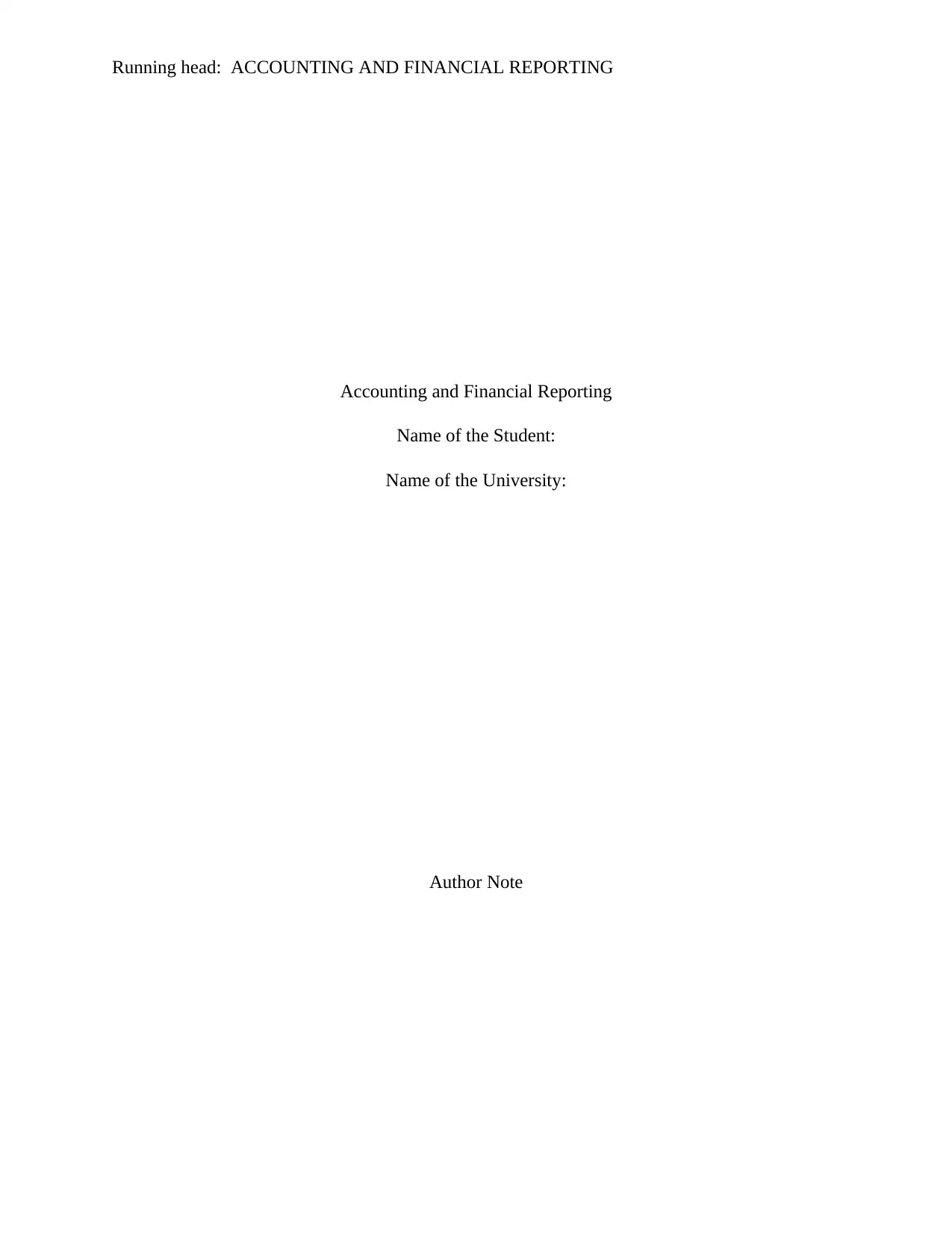
Running head: ACCOUNTING AND FINANCIAL REPORTING
Accounting and Financial Reporting
Name of the Student:
Name of the University:
Author Note
Accounting and Financial Reporting
Name of the Student:
Name of the University:
Author Note
Paraphrase This Document
Need a fresh take? Get an instant paraphrase of this document with our AI Paraphraser
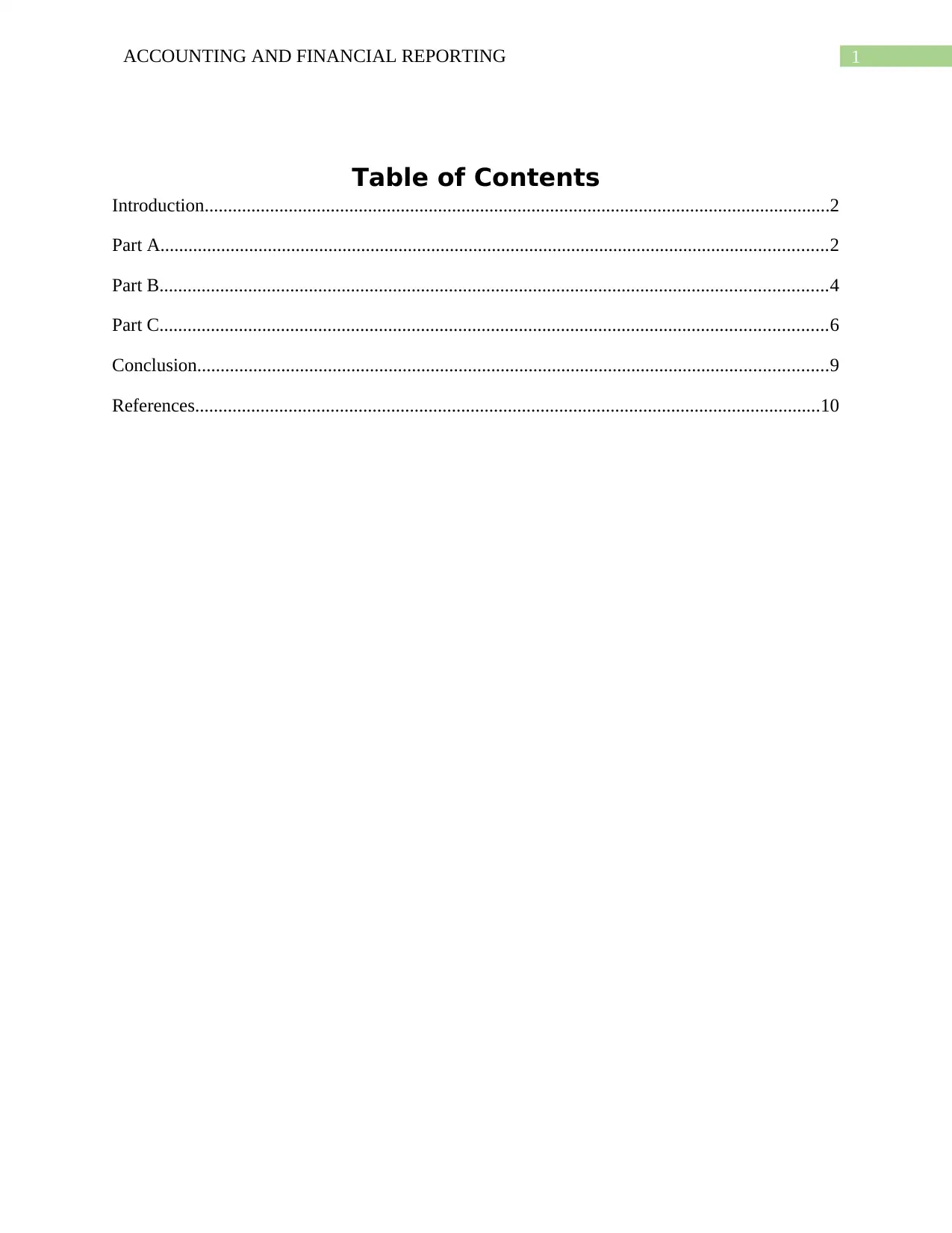
1ACCOUNTING AND FINANCIAL REPORTING
Table of Contents
Introduction......................................................................................................................................2
Part A...............................................................................................................................................2
Part B...............................................................................................................................................4
Part C...............................................................................................................................................6
Conclusion.......................................................................................................................................9
References......................................................................................................................................10
Table of Contents
Introduction......................................................................................................................................2
Part A...............................................................................................................................................2
Part B...............................................................................................................................................4
Part C...............................................................................................................................................6
Conclusion.......................................................................................................................................9
References......................................................................................................................................10
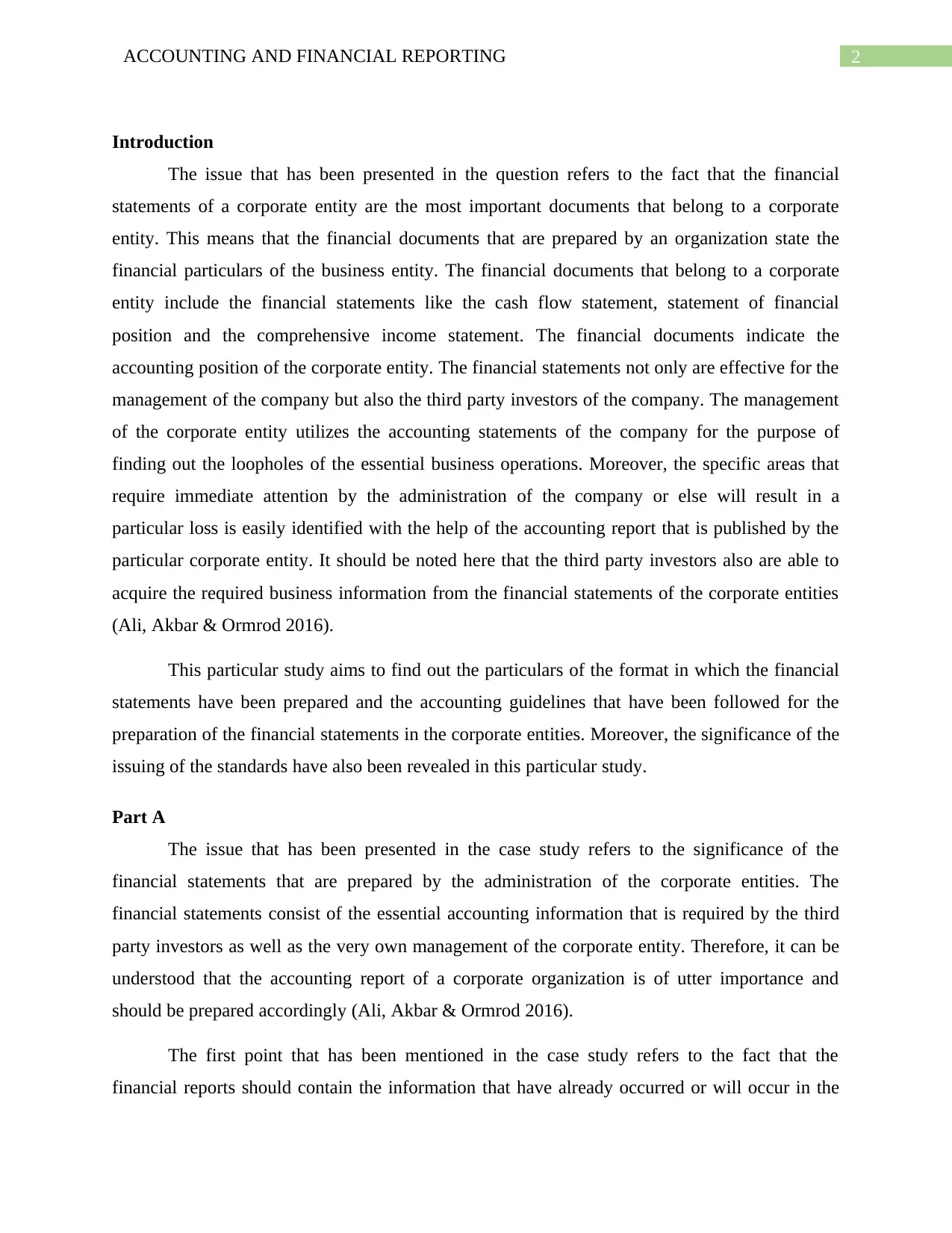
2ACCOUNTING AND FINANCIAL REPORTING
Introduction
The issue that has been presented in the question refers to the fact that the financial
statements of a corporate entity are the most important documents that belong to a corporate
entity. This means that the financial documents that are prepared by an organization state the
financial particulars of the business entity. The financial documents that belong to a corporate
entity include the financial statements like the cash flow statement, statement of financial
position and the comprehensive income statement. The financial documents indicate the
accounting position of the corporate entity. The financial statements not only are effective for the
management of the company but also the third party investors of the company. The management
of the corporate entity utilizes the accounting statements of the company for the purpose of
finding out the loopholes of the essential business operations. Moreover, the specific areas that
require immediate attention by the administration of the company or else will result in a
particular loss is easily identified with the help of the accounting report that is published by the
particular corporate entity. It should be noted here that the third party investors also are able to
acquire the required business information from the financial statements of the corporate entities
(Ali, Akbar & Ormrod 2016).
This particular study aims to find out the particulars of the format in which the financial
statements have been prepared and the accounting guidelines that have been followed for the
preparation of the financial statements in the corporate entities. Moreover, the significance of the
issuing of the standards have also been revealed in this particular study.
Part A
The issue that has been presented in the case study refers to the significance of the
financial statements that are prepared by the administration of the corporate entities. The
financial statements consist of the essential accounting information that is required by the third
party investors as well as the very own management of the corporate entity. Therefore, it can be
understood that the accounting report of a corporate organization is of utter importance and
should be prepared accordingly (Ali, Akbar & Ormrod 2016).
The first point that has been mentioned in the case study refers to the fact that the
financial reports should contain the information that have already occurred or will occur in the
Introduction
The issue that has been presented in the question refers to the fact that the financial
statements of a corporate entity are the most important documents that belong to a corporate
entity. This means that the financial documents that are prepared by an organization state the
financial particulars of the business entity. The financial documents that belong to a corporate
entity include the financial statements like the cash flow statement, statement of financial
position and the comprehensive income statement. The financial documents indicate the
accounting position of the corporate entity. The financial statements not only are effective for the
management of the company but also the third party investors of the company. The management
of the corporate entity utilizes the accounting statements of the company for the purpose of
finding out the loopholes of the essential business operations. Moreover, the specific areas that
require immediate attention by the administration of the company or else will result in a
particular loss is easily identified with the help of the accounting report that is published by the
particular corporate entity. It should be noted here that the third party investors also are able to
acquire the required business information from the financial statements of the corporate entities
(Ali, Akbar & Ormrod 2016).
This particular study aims to find out the particulars of the format in which the financial
statements have been prepared and the accounting guidelines that have been followed for the
preparation of the financial statements in the corporate entities. Moreover, the significance of the
issuing of the standards have also been revealed in this particular study.
Part A
The issue that has been presented in the case study refers to the significance of the
financial statements that are prepared by the administration of the corporate entities. The
financial statements consist of the essential accounting information that is required by the third
party investors as well as the very own management of the corporate entity. Therefore, it can be
understood that the accounting report of a corporate organization is of utter importance and
should be prepared accordingly (Ali, Akbar & Ormrod 2016).
The first point that has been mentioned in the case study refers to the fact that the
financial reports should contain the information that have already occurred or will occur in the
⊘ This is a preview!⊘
Do you want full access?
Subscribe today to unlock all pages.

Trusted by 1+ million students worldwide
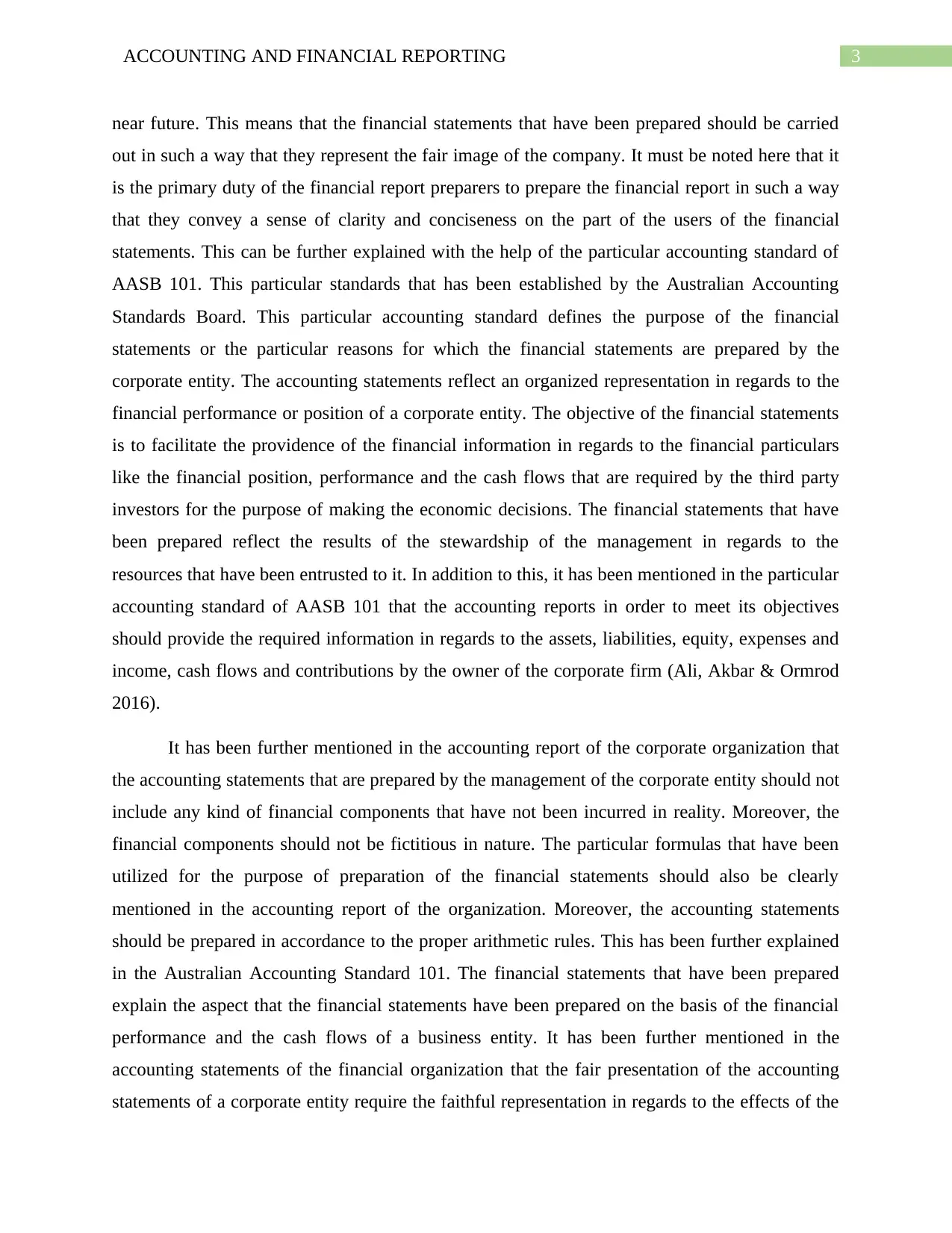
3ACCOUNTING AND FINANCIAL REPORTING
near future. This means that the financial statements that have been prepared should be carried
out in such a way that they represent the fair image of the company. It must be noted here that it
is the primary duty of the financial report preparers to prepare the financial report in such a way
that they convey a sense of clarity and conciseness on the part of the users of the financial
statements. This can be further explained with the help of the particular accounting standard of
AASB 101. This particular standards that has been established by the Australian Accounting
Standards Board. This particular accounting standard defines the purpose of the financial
statements or the particular reasons for which the financial statements are prepared by the
corporate entity. The accounting statements reflect an organized representation in regards to the
financial performance or position of a corporate entity. The objective of the financial statements
is to facilitate the providence of the financial information in regards to the financial particulars
like the financial position, performance and the cash flows that are required by the third party
investors for the purpose of making the economic decisions. The financial statements that have
been prepared reflect the results of the stewardship of the management in regards to the
resources that have been entrusted to it. In addition to this, it has been mentioned in the particular
accounting standard of AASB 101 that the accounting reports in order to meet its objectives
should provide the required information in regards to the assets, liabilities, equity, expenses and
income, cash flows and contributions by the owner of the corporate firm (Ali, Akbar & Ormrod
2016).
It has been further mentioned in the accounting report of the corporate organization that
the accounting statements that are prepared by the management of the corporate entity should not
include any kind of financial components that have not been incurred in reality. Moreover, the
financial components should not be fictitious in nature. The particular formulas that have been
utilized for the purpose of preparation of the financial statements should also be clearly
mentioned in the accounting report of the organization. Moreover, the accounting statements
should be prepared in accordance to the proper arithmetic rules. This has been further explained
in the Australian Accounting Standard 101. The financial statements that have been prepared
explain the aspect that the financial statements have been prepared on the basis of the financial
performance and the cash flows of a business entity. It has been further mentioned in the
accounting statements of the financial organization that the fair presentation of the accounting
statements of a corporate entity require the faithful representation in regards to the effects of the
near future. This means that the financial statements that have been prepared should be carried
out in such a way that they represent the fair image of the company. It must be noted here that it
is the primary duty of the financial report preparers to prepare the financial report in such a way
that they convey a sense of clarity and conciseness on the part of the users of the financial
statements. This can be further explained with the help of the particular accounting standard of
AASB 101. This particular standards that has been established by the Australian Accounting
Standards Board. This particular accounting standard defines the purpose of the financial
statements or the particular reasons for which the financial statements are prepared by the
corporate entity. The accounting statements reflect an organized representation in regards to the
financial performance or position of a corporate entity. The objective of the financial statements
is to facilitate the providence of the financial information in regards to the financial particulars
like the financial position, performance and the cash flows that are required by the third party
investors for the purpose of making the economic decisions. The financial statements that have
been prepared reflect the results of the stewardship of the management in regards to the
resources that have been entrusted to it. In addition to this, it has been mentioned in the particular
accounting standard of AASB 101 that the accounting reports in order to meet its objectives
should provide the required information in regards to the assets, liabilities, equity, expenses and
income, cash flows and contributions by the owner of the corporate firm (Ali, Akbar & Ormrod
2016).
It has been further mentioned in the accounting report of the corporate organization that
the accounting statements that are prepared by the management of the corporate entity should not
include any kind of financial components that have not been incurred in reality. Moreover, the
financial components should not be fictitious in nature. The particular formulas that have been
utilized for the purpose of preparation of the financial statements should also be clearly
mentioned in the accounting report of the organization. Moreover, the accounting statements
should be prepared in accordance to the proper arithmetic rules. This has been further explained
in the Australian Accounting Standard 101. The financial statements that have been prepared
explain the aspect that the financial statements have been prepared on the basis of the financial
performance and the cash flows of a business entity. It has been further mentioned in the
accounting statements of the financial organization that the fair presentation of the accounting
statements of a corporate entity require the faithful representation in regards to the effects of the
Paraphrase This Document
Need a fresh take? Get an instant paraphrase of this document with our AI Paraphraser
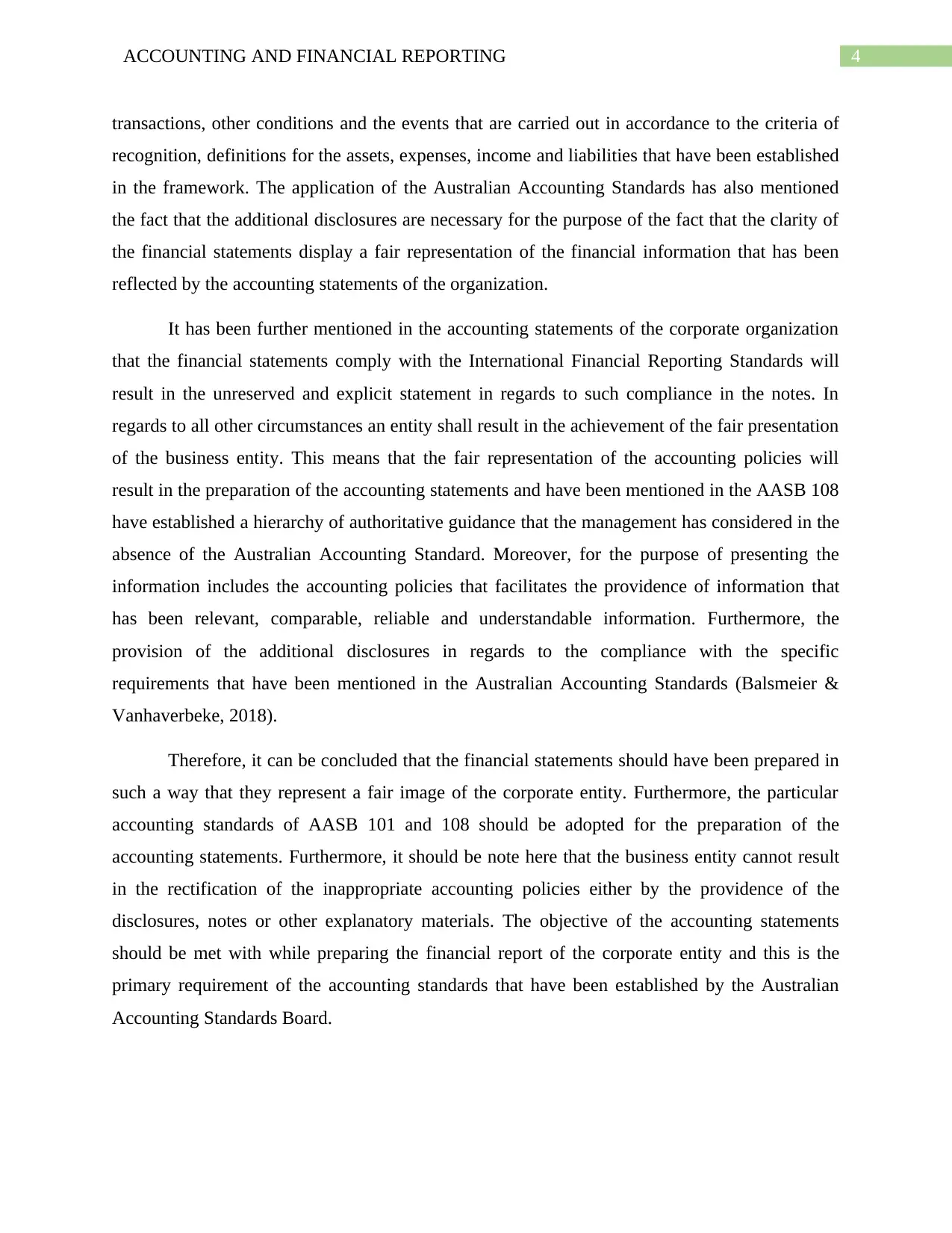
4ACCOUNTING AND FINANCIAL REPORTING
transactions, other conditions and the events that are carried out in accordance to the criteria of
recognition, definitions for the assets, expenses, income and liabilities that have been established
in the framework. The application of the Australian Accounting Standards has also mentioned
the fact that the additional disclosures are necessary for the purpose of the fact that the clarity of
the financial statements display a fair representation of the financial information that has been
reflected by the accounting statements of the organization.
It has been further mentioned in the accounting statements of the corporate organization
that the financial statements comply with the International Financial Reporting Standards will
result in the unreserved and explicit statement in regards to such compliance in the notes. In
regards to all other circumstances an entity shall result in the achievement of the fair presentation
of the business entity. This means that the fair representation of the accounting policies will
result in the preparation of the accounting statements and have been mentioned in the AASB 108
have established a hierarchy of authoritative guidance that the management has considered in the
absence of the Australian Accounting Standard. Moreover, for the purpose of presenting the
information includes the accounting policies that facilitates the providence of information that
has been relevant, comparable, reliable and understandable information. Furthermore, the
provision of the additional disclosures in regards to the compliance with the specific
requirements that have been mentioned in the Australian Accounting Standards (Balsmeier &
Vanhaverbeke, 2018).
Therefore, it can be concluded that the financial statements should have been prepared in
such a way that they represent a fair image of the corporate entity. Furthermore, the particular
accounting standards of AASB 101 and 108 should be adopted for the preparation of the
accounting statements. Furthermore, it should be note here that the business entity cannot result
in the rectification of the inappropriate accounting policies either by the providence of the
disclosures, notes or other explanatory materials. The objective of the accounting statements
should be met with while preparing the financial report of the corporate entity and this is the
primary requirement of the accounting standards that have been established by the Australian
Accounting Standards Board.
transactions, other conditions and the events that are carried out in accordance to the criteria of
recognition, definitions for the assets, expenses, income and liabilities that have been established
in the framework. The application of the Australian Accounting Standards has also mentioned
the fact that the additional disclosures are necessary for the purpose of the fact that the clarity of
the financial statements display a fair representation of the financial information that has been
reflected by the accounting statements of the organization.
It has been further mentioned in the accounting statements of the corporate organization
that the financial statements comply with the International Financial Reporting Standards will
result in the unreserved and explicit statement in regards to such compliance in the notes. In
regards to all other circumstances an entity shall result in the achievement of the fair presentation
of the business entity. This means that the fair representation of the accounting policies will
result in the preparation of the accounting statements and have been mentioned in the AASB 108
have established a hierarchy of authoritative guidance that the management has considered in the
absence of the Australian Accounting Standard. Moreover, for the purpose of presenting the
information includes the accounting policies that facilitates the providence of information that
has been relevant, comparable, reliable and understandable information. Furthermore, the
provision of the additional disclosures in regards to the compliance with the specific
requirements that have been mentioned in the Australian Accounting Standards (Balsmeier &
Vanhaverbeke, 2018).
Therefore, it can be concluded that the financial statements should have been prepared in
such a way that they represent a fair image of the corporate entity. Furthermore, the particular
accounting standards of AASB 101 and 108 should be adopted for the preparation of the
accounting statements. Furthermore, it should be note here that the business entity cannot result
in the rectification of the inappropriate accounting policies either by the providence of the
disclosures, notes or other explanatory materials. The objective of the accounting statements
should be met with while preparing the financial report of the corporate entity and this is the
primary requirement of the accounting standards that have been established by the Australian
Accounting Standards Board.
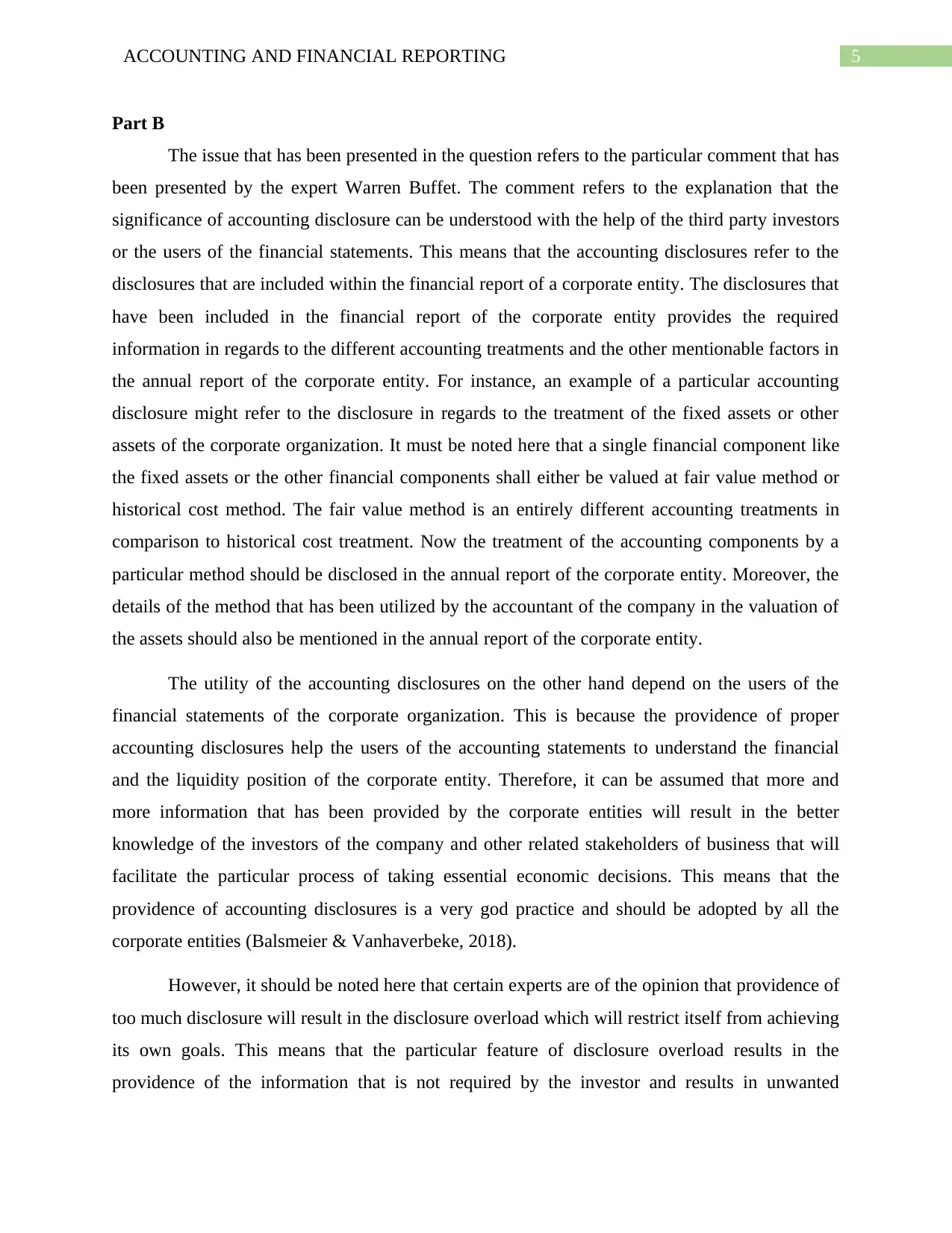
5ACCOUNTING AND FINANCIAL REPORTING
Part B
The issue that has been presented in the question refers to the particular comment that has
been presented by the expert Warren Buffet. The comment refers to the explanation that the
significance of accounting disclosure can be understood with the help of the third party investors
or the users of the financial statements. This means that the accounting disclosures refer to the
disclosures that are included within the financial report of a corporate entity. The disclosures that
have been included in the financial report of the corporate entity provides the required
information in regards to the different accounting treatments and the other mentionable factors in
the annual report of the corporate entity. For instance, an example of a particular accounting
disclosure might refer to the disclosure in regards to the treatment of the fixed assets or other
assets of the corporate organization. It must be noted here that a single financial component like
the fixed assets or the other financial components shall either be valued at fair value method or
historical cost method. The fair value method is an entirely different accounting treatments in
comparison to historical cost treatment. Now the treatment of the accounting components by a
particular method should be disclosed in the annual report of the corporate entity. Moreover, the
details of the method that has been utilized by the accountant of the company in the valuation of
the assets should also be mentioned in the annual report of the corporate entity.
The utility of the accounting disclosures on the other hand depend on the users of the
financial statements of the corporate organization. This is because the providence of proper
accounting disclosures help the users of the accounting statements to understand the financial
and the liquidity position of the corporate entity. Therefore, it can be assumed that more and
more information that has been provided by the corporate entities will result in the better
knowledge of the investors of the company and other related stakeholders of business that will
facilitate the particular process of taking essential economic decisions. This means that the
providence of accounting disclosures is a very god practice and should be adopted by all the
corporate entities (Balsmeier & Vanhaverbeke, 2018).
However, it should be noted here that certain experts are of the opinion that providence of
too much disclosure will result in the disclosure overload which will restrict itself from achieving
its own goals. This means that the particular feature of disclosure overload results in the
providence of the information that is not required by the investor and results in unwanted
Part B
The issue that has been presented in the question refers to the particular comment that has
been presented by the expert Warren Buffet. The comment refers to the explanation that the
significance of accounting disclosure can be understood with the help of the third party investors
or the users of the financial statements. This means that the accounting disclosures refer to the
disclosures that are included within the financial report of a corporate entity. The disclosures that
have been included in the financial report of the corporate entity provides the required
information in regards to the different accounting treatments and the other mentionable factors in
the annual report of the corporate entity. For instance, an example of a particular accounting
disclosure might refer to the disclosure in regards to the treatment of the fixed assets or other
assets of the corporate organization. It must be noted here that a single financial component like
the fixed assets or the other financial components shall either be valued at fair value method or
historical cost method. The fair value method is an entirely different accounting treatments in
comparison to historical cost treatment. Now the treatment of the accounting components by a
particular method should be disclosed in the annual report of the corporate entity. Moreover, the
details of the method that has been utilized by the accountant of the company in the valuation of
the assets should also be mentioned in the annual report of the corporate entity.
The utility of the accounting disclosures on the other hand depend on the users of the
financial statements of the corporate organization. This is because the providence of proper
accounting disclosures help the users of the accounting statements to understand the financial
and the liquidity position of the corporate entity. Therefore, it can be assumed that more and
more information that has been provided by the corporate entities will result in the better
knowledge of the investors of the company and other related stakeholders of business that will
facilitate the particular process of taking essential economic decisions. This means that the
providence of accounting disclosures is a very god practice and should be adopted by all the
corporate entities (Balsmeier & Vanhaverbeke, 2018).
However, it should be noted here that certain experts are of the opinion that providence of
too much disclosure will result in the disclosure overload which will restrict itself from achieving
its own goals. This means that the particular feature of disclosure overload results in the
providence of the information that is not required by the investor and results in unwanted
⊘ This is a preview!⊘
Do you want full access?
Subscribe today to unlock all pages.

Trusted by 1+ million students worldwide
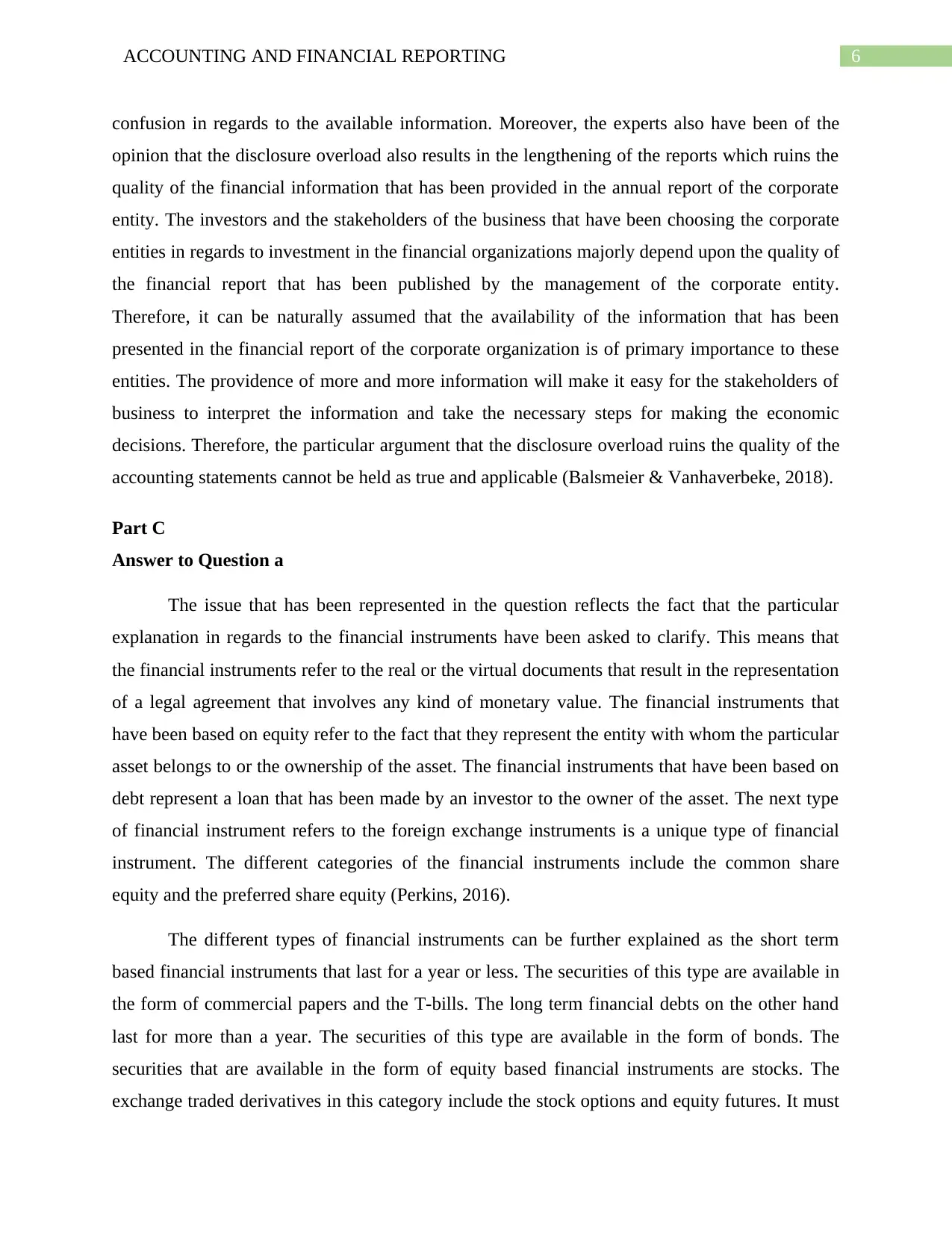
6ACCOUNTING AND FINANCIAL REPORTING
confusion in regards to the available information. Moreover, the experts also have been of the
opinion that the disclosure overload also results in the lengthening of the reports which ruins the
quality of the financial information that has been provided in the annual report of the corporate
entity. The investors and the stakeholders of the business that have been choosing the corporate
entities in regards to investment in the financial organizations majorly depend upon the quality of
the financial report that has been published by the management of the corporate entity.
Therefore, it can be naturally assumed that the availability of the information that has been
presented in the financial report of the corporate organization is of primary importance to these
entities. The providence of more and more information will make it easy for the stakeholders of
business to interpret the information and take the necessary steps for making the economic
decisions. Therefore, the particular argument that the disclosure overload ruins the quality of the
accounting statements cannot be held as true and applicable (Balsmeier & Vanhaverbeke, 2018).
Part C
Answer to Question a
The issue that has been represented in the question reflects the fact that the particular
explanation in regards to the financial instruments have been asked to clarify. This means that
the financial instruments refer to the real or the virtual documents that result in the representation
of a legal agreement that involves any kind of monetary value. The financial instruments that
have been based on equity refer to the fact that they represent the entity with whom the particular
asset belongs to or the ownership of the asset. The financial instruments that have been based on
debt represent a loan that has been made by an investor to the owner of the asset. The next type
of financial instrument refers to the foreign exchange instruments is a unique type of financial
instrument. The different categories of the financial instruments include the common share
equity and the preferred share equity (Perkins, 2016).
The different types of financial instruments can be further explained as the short term
based financial instruments that last for a year or less. The securities of this type are available in
the form of commercial papers and the T-bills. The long term financial debts on the other hand
last for more than a year. The securities of this type are available in the form of bonds. The
securities that are available in the form of equity based financial instruments are stocks. The
exchange traded derivatives in this category include the stock options and equity futures. It must
confusion in regards to the available information. Moreover, the experts also have been of the
opinion that the disclosure overload also results in the lengthening of the reports which ruins the
quality of the financial information that has been provided in the annual report of the corporate
entity. The investors and the stakeholders of the business that have been choosing the corporate
entities in regards to investment in the financial organizations majorly depend upon the quality of
the financial report that has been published by the management of the corporate entity.
Therefore, it can be naturally assumed that the availability of the information that has been
presented in the financial report of the corporate organization is of primary importance to these
entities. The providence of more and more information will make it easy for the stakeholders of
business to interpret the information and take the necessary steps for making the economic
decisions. Therefore, the particular argument that the disclosure overload ruins the quality of the
accounting statements cannot be held as true and applicable (Balsmeier & Vanhaverbeke, 2018).
Part C
Answer to Question a
The issue that has been represented in the question reflects the fact that the particular
explanation in regards to the financial instruments have been asked to clarify. This means that
the financial instruments refer to the real or the virtual documents that result in the representation
of a legal agreement that involves any kind of monetary value. The financial instruments that
have been based on equity refer to the fact that they represent the entity with whom the particular
asset belongs to or the ownership of the asset. The financial instruments that have been based on
debt represent a loan that has been made by an investor to the owner of the asset. The next type
of financial instrument refers to the foreign exchange instruments is a unique type of financial
instrument. The different categories of the financial instruments include the common share
equity and the preferred share equity (Perkins, 2016).
The different types of financial instruments can be further explained as the short term
based financial instruments that last for a year or less. The securities of this type are available in
the form of commercial papers and the T-bills. The long term financial debts on the other hand
last for more than a year. The securities of this type are available in the form of bonds. The
securities that are available in the form of equity based financial instruments are stocks. The
exchange traded derivatives in this category include the stock options and equity futures. It must
Paraphrase This Document
Need a fresh take? Get an instant paraphrase of this document with our AI Paraphraser
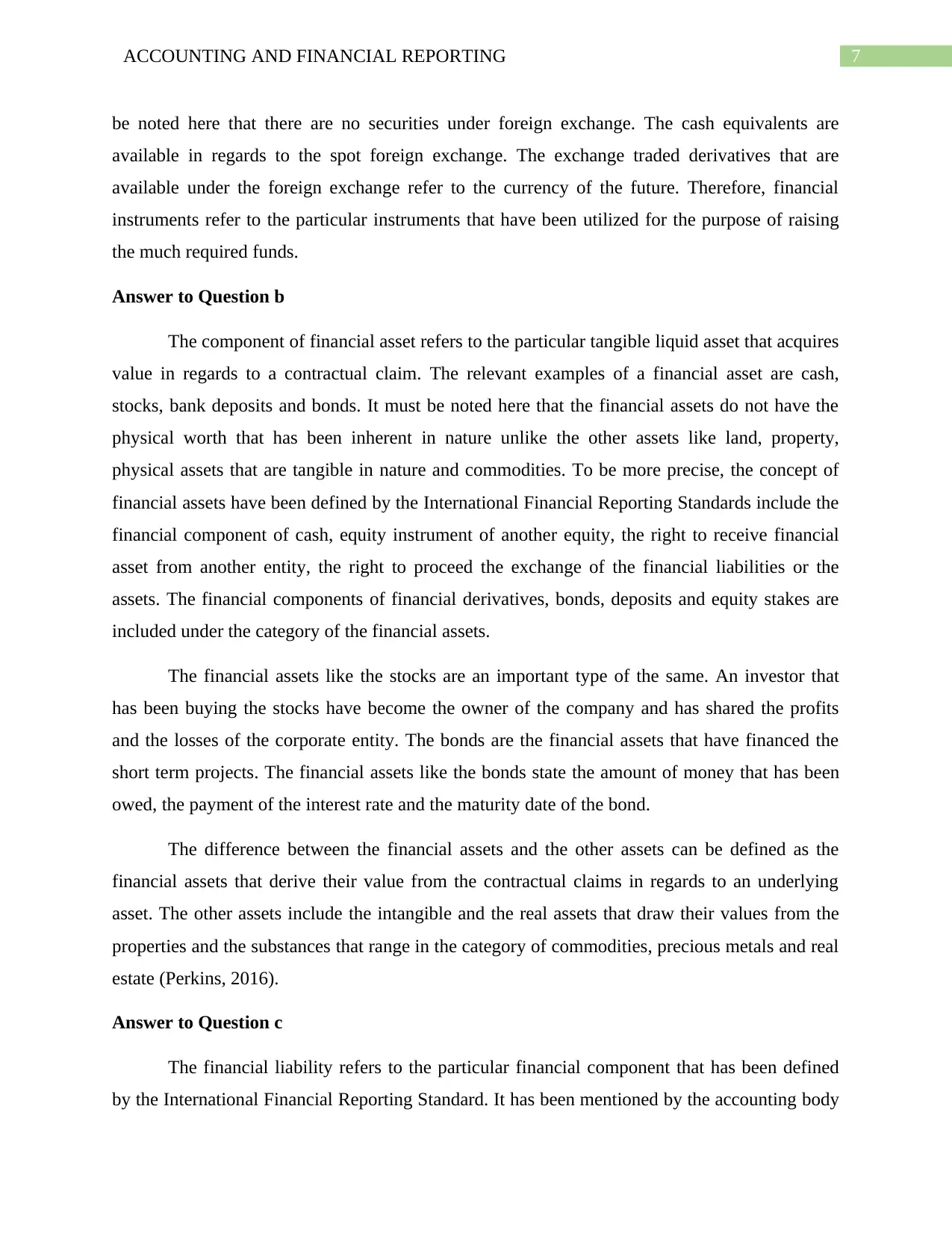
7ACCOUNTING AND FINANCIAL REPORTING
be noted here that there are no securities under foreign exchange. The cash equivalents are
available in regards to the spot foreign exchange. The exchange traded derivatives that are
available under the foreign exchange refer to the currency of the future. Therefore, financial
instruments refer to the particular instruments that have been utilized for the purpose of raising
the much required funds.
Answer to Question b
The component of financial asset refers to the particular tangible liquid asset that acquires
value in regards to a contractual claim. The relevant examples of a financial asset are cash,
stocks, bank deposits and bonds. It must be noted here that the financial assets do not have the
physical worth that has been inherent in nature unlike the other assets like land, property,
physical assets that are tangible in nature and commodities. To be more precise, the concept of
financial assets have been defined by the International Financial Reporting Standards include the
financial component of cash, equity instrument of another equity, the right to receive financial
asset from another entity, the right to proceed the exchange of the financial liabilities or the
assets. The financial components of financial derivatives, bonds, deposits and equity stakes are
included under the category of the financial assets.
The financial assets like the stocks are an important type of the same. An investor that
has been buying the stocks have become the owner of the company and has shared the profits
and the losses of the corporate entity. The bonds are the financial assets that have financed the
short term projects. The financial assets like the bonds state the amount of money that has been
owed, the payment of the interest rate and the maturity date of the bond.
The difference between the financial assets and the other assets can be defined as the
financial assets that derive their value from the contractual claims in regards to an underlying
asset. The other assets include the intangible and the real assets that draw their values from the
properties and the substances that range in the category of commodities, precious metals and real
estate (Perkins, 2016).
Answer to Question c
The financial liability refers to the particular financial component that has been defined
by the International Financial Reporting Standard. It has been mentioned by the accounting body
be noted here that there are no securities under foreign exchange. The cash equivalents are
available in regards to the spot foreign exchange. The exchange traded derivatives that are
available under the foreign exchange refer to the currency of the future. Therefore, financial
instruments refer to the particular instruments that have been utilized for the purpose of raising
the much required funds.
Answer to Question b
The component of financial asset refers to the particular tangible liquid asset that acquires
value in regards to a contractual claim. The relevant examples of a financial asset are cash,
stocks, bank deposits and bonds. It must be noted here that the financial assets do not have the
physical worth that has been inherent in nature unlike the other assets like land, property,
physical assets that are tangible in nature and commodities. To be more precise, the concept of
financial assets have been defined by the International Financial Reporting Standards include the
financial component of cash, equity instrument of another equity, the right to receive financial
asset from another entity, the right to proceed the exchange of the financial liabilities or the
assets. The financial components of financial derivatives, bonds, deposits and equity stakes are
included under the category of the financial assets.
The financial assets like the stocks are an important type of the same. An investor that
has been buying the stocks have become the owner of the company and has shared the profits
and the losses of the corporate entity. The bonds are the financial assets that have financed the
short term projects. The financial assets like the bonds state the amount of money that has been
owed, the payment of the interest rate and the maturity date of the bond.
The difference between the financial assets and the other assets can be defined as the
financial assets that derive their value from the contractual claims in regards to an underlying
asset. The other assets include the intangible and the real assets that draw their values from the
properties and the substances that range in the category of commodities, precious metals and real
estate (Perkins, 2016).
Answer to Question c
The financial liability refers to the particular financial component that has been defined
by the International Financial Reporting Standard. It has been mentioned by the accounting body
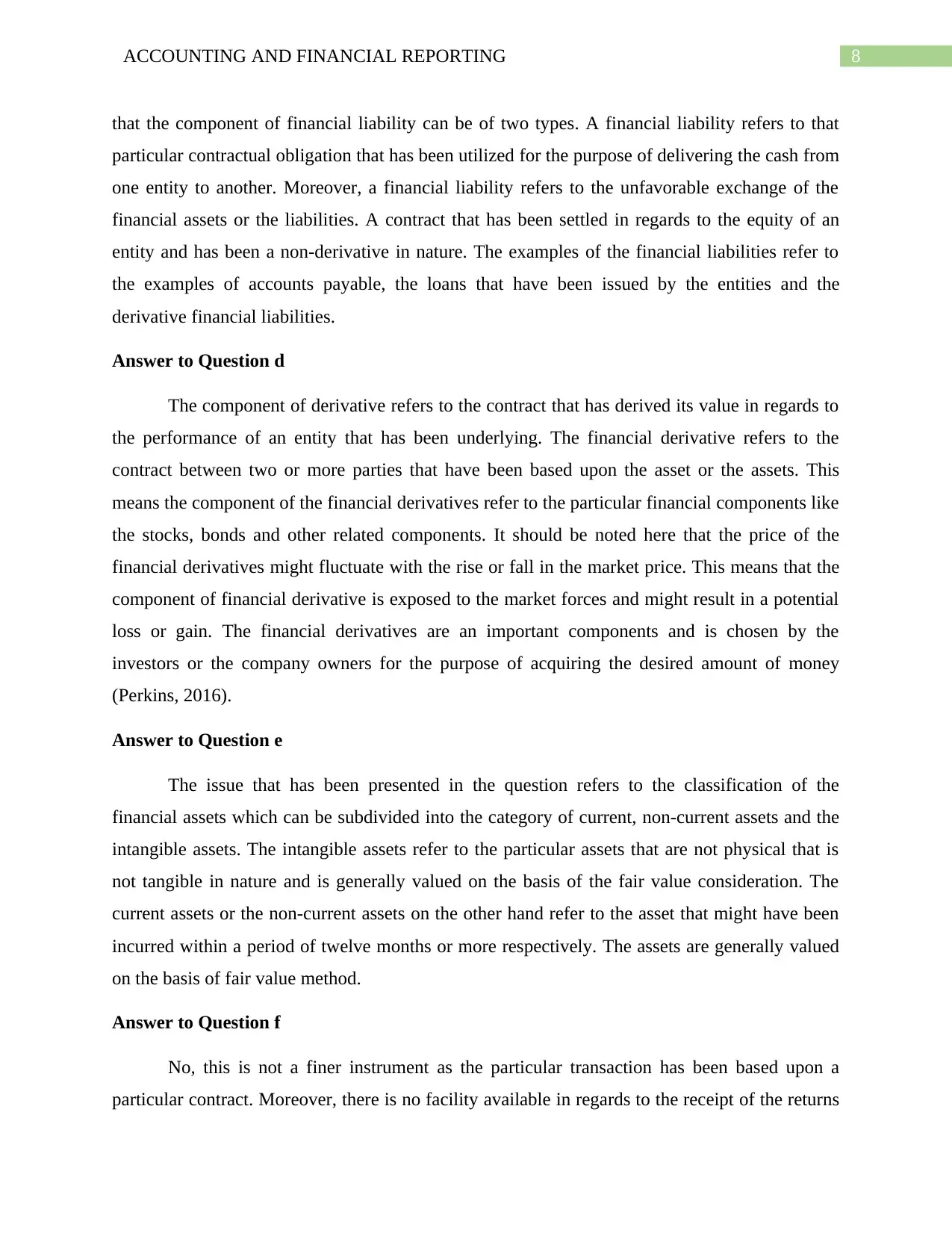
8ACCOUNTING AND FINANCIAL REPORTING
that the component of financial liability can be of two types. A financial liability refers to that
particular contractual obligation that has been utilized for the purpose of delivering the cash from
one entity to another. Moreover, a financial liability refers to the unfavorable exchange of the
financial assets or the liabilities. A contract that has been settled in regards to the equity of an
entity and has been a non-derivative in nature. The examples of the financial liabilities refer to
the examples of accounts payable, the loans that have been issued by the entities and the
derivative financial liabilities.
Answer to Question d
The component of derivative refers to the contract that has derived its value in regards to
the performance of an entity that has been underlying. The financial derivative refers to the
contract between two or more parties that have been based upon the asset or the assets. This
means the component of the financial derivatives refer to the particular financial components like
the stocks, bonds and other related components. It should be noted here that the price of the
financial derivatives might fluctuate with the rise or fall in the market price. This means that the
component of financial derivative is exposed to the market forces and might result in a potential
loss or gain. The financial derivatives are an important components and is chosen by the
investors or the company owners for the purpose of acquiring the desired amount of money
(Perkins, 2016).
Answer to Question e
The issue that has been presented in the question refers to the classification of the
financial assets which can be subdivided into the category of current, non-current assets and the
intangible assets. The intangible assets refer to the particular assets that are not physical that is
not tangible in nature and is generally valued on the basis of the fair value consideration. The
current assets or the non-current assets on the other hand refer to the asset that might have been
incurred within a period of twelve months or more respectively. The assets are generally valued
on the basis of fair value method.
Answer to Question f
No, this is not a finer instrument as the particular transaction has been based upon a
particular contract. Moreover, there is no facility available in regards to the receipt of the returns
that the component of financial liability can be of two types. A financial liability refers to that
particular contractual obligation that has been utilized for the purpose of delivering the cash from
one entity to another. Moreover, a financial liability refers to the unfavorable exchange of the
financial assets or the liabilities. A contract that has been settled in regards to the equity of an
entity and has been a non-derivative in nature. The examples of the financial liabilities refer to
the examples of accounts payable, the loans that have been issued by the entities and the
derivative financial liabilities.
Answer to Question d
The component of derivative refers to the contract that has derived its value in regards to
the performance of an entity that has been underlying. The financial derivative refers to the
contract between two or more parties that have been based upon the asset or the assets. This
means the component of the financial derivatives refer to the particular financial components like
the stocks, bonds and other related components. It should be noted here that the price of the
financial derivatives might fluctuate with the rise or fall in the market price. This means that the
component of financial derivative is exposed to the market forces and might result in a potential
loss or gain. The financial derivatives are an important components and is chosen by the
investors or the company owners for the purpose of acquiring the desired amount of money
(Perkins, 2016).
Answer to Question e
The issue that has been presented in the question refers to the classification of the
financial assets which can be subdivided into the category of current, non-current assets and the
intangible assets. The intangible assets refer to the particular assets that are not physical that is
not tangible in nature and is generally valued on the basis of the fair value consideration. The
current assets or the non-current assets on the other hand refer to the asset that might have been
incurred within a period of twelve months or more respectively. The assets are generally valued
on the basis of fair value method.
Answer to Question f
No, this is not a finer instrument as the particular transaction has been based upon a
particular contract. Moreover, there is no facility available in regards to the receipt of the returns
⊘ This is a preview!⊘
Do you want full access?
Subscribe today to unlock all pages.

Trusted by 1+ million students worldwide
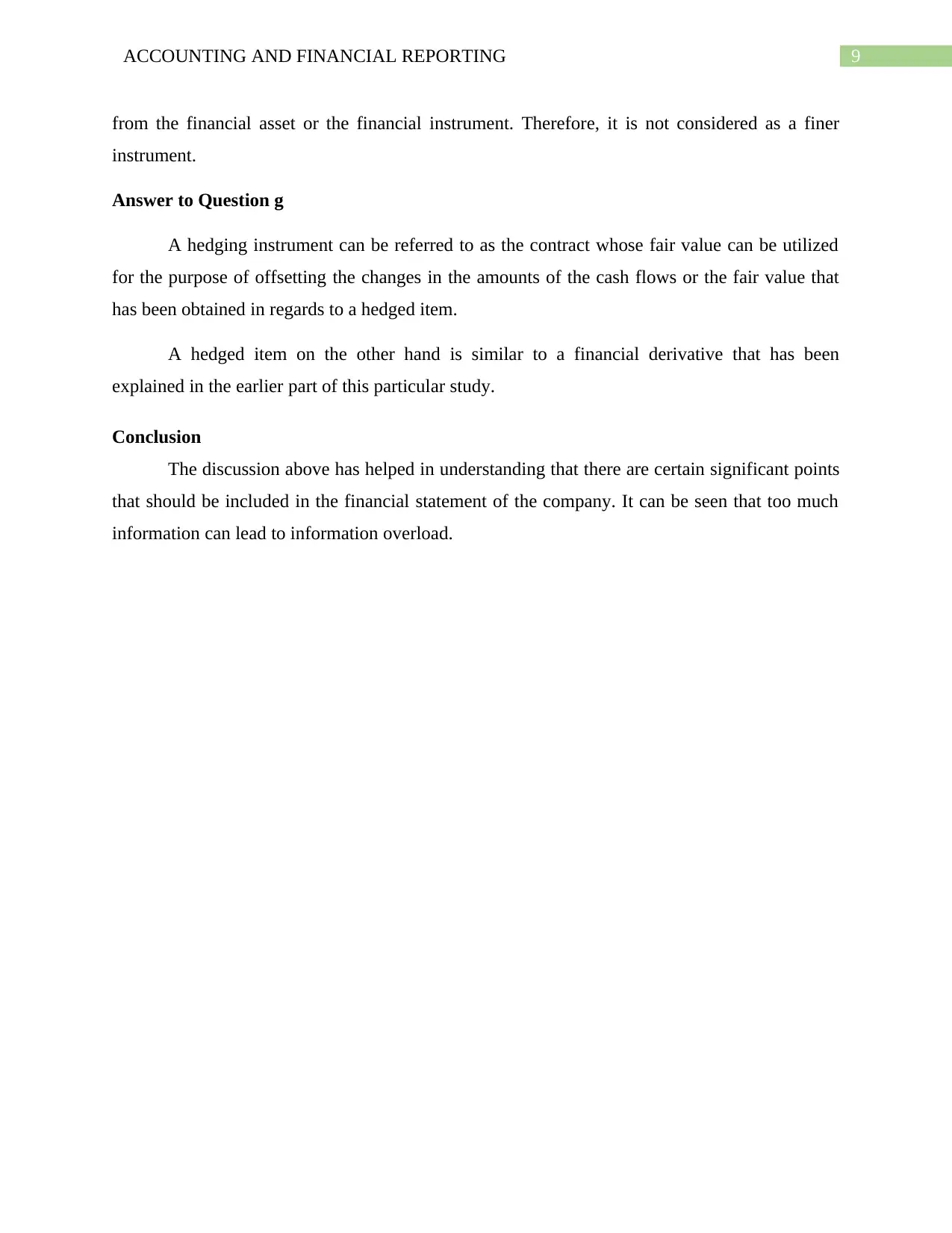
9ACCOUNTING AND FINANCIAL REPORTING
from the financial asset or the financial instrument. Therefore, it is not considered as a finer
instrument.
Answer to Question g
A hedging instrument can be referred to as the contract whose fair value can be utilized
for the purpose of offsetting the changes in the amounts of the cash flows or the fair value that
has been obtained in regards to a hedged item.
A hedged item on the other hand is similar to a financial derivative that has been
explained in the earlier part of this particular study.
Conclusion
The discussion above has helped in understanding that there are certain significant points
that should be included in the financial statement of the company. It can be seen that too much
information can lead to information overload.
from the financial asset or the financial instrument. Therefore, it is not considered as a finer
instrument.
Answer to Question g
A hedging instrument can be referred to as the contract whose fair value can be utilized
for the purpose of offsetting the changes in the amounts of the cash flows or the fair value that
has been obtained in regards to a hedged item.
A hedged item on the other hand is similar to a financial derivative that has been
explained in the earlier part of this particular study.
Conclusion
The discussion above has helped in understanding that there are certain significant points
that should be included in the financial statement of the company. It can be seen that too much
information can lead to information overload.
Paraphrase This Document
Need a fresh take? Get an instant paraphrase of this document with our AI Paraphraser
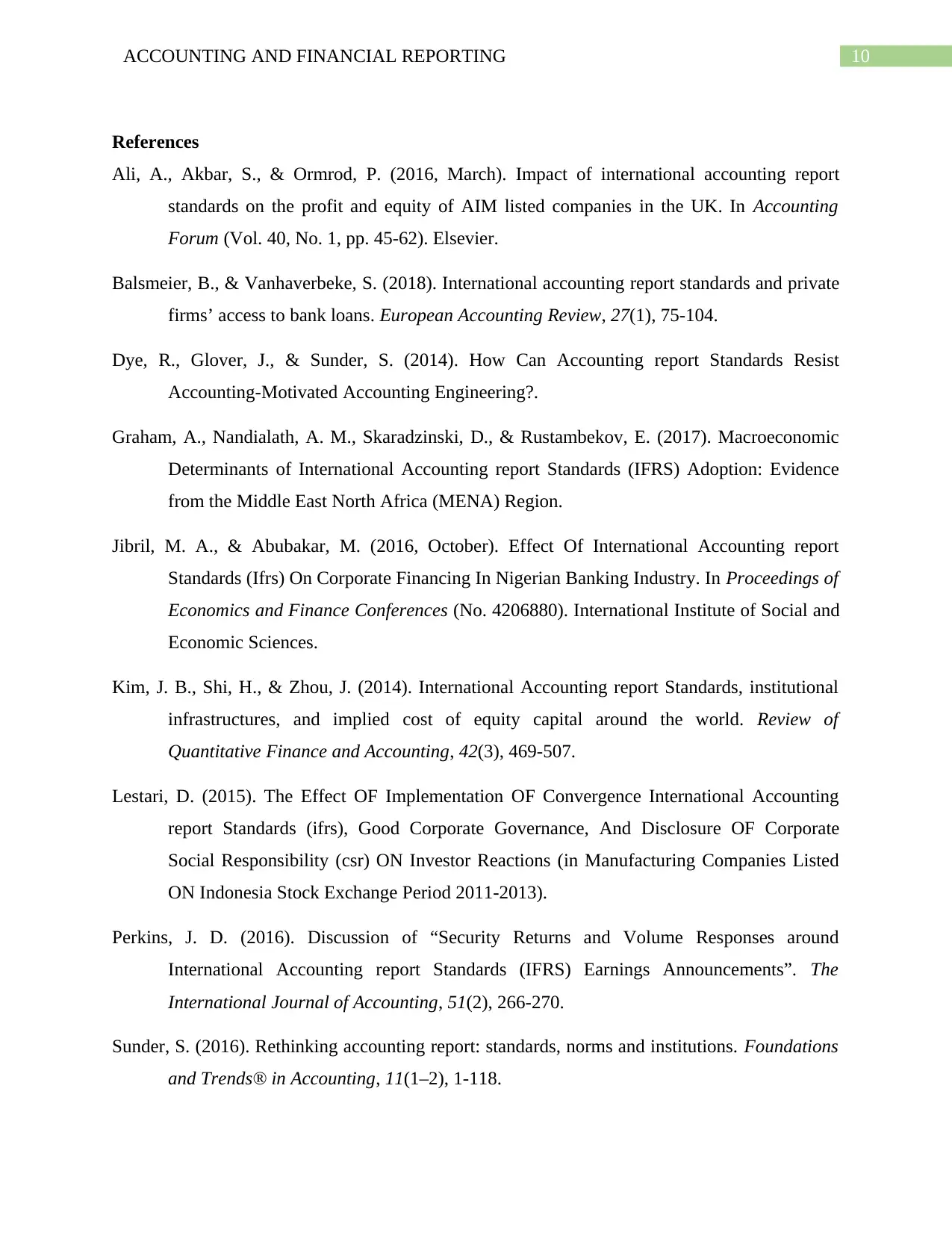
10ACCOUNTING AND FINANCIAL REPORTING
References
Ali, A., Akbar, S., & Ormrod, P. (2016, March). Impact of international accounting report
standards on the profit and equity of AIM listed companies in the UK. In Accounting
Forum (Vol. 40, No. 1, pp. 45-62). Elsevier.
Balsmeier, B., & Vanhaverbeke, S. (2018). International accounting report standards and private
firms’ access to bank loans. European Accounting Review, 27(1), 75-104.
Dye, R., Glover, J., & Sunder, S. (2014). How Can Accounting report Standards Resist
Accounting-Motivated Accounting Engineering?.
Graham, A., Nandialath, A. M., Skaradzinski, D., & Rustambekov, E. (2017). Macroeconomic
Determinants of International Accounting report Standards (IFRS) Adoption: Evidence
from the Middle East North Africa (MENA) Region.
Jibril, M. A., & Abubakar, M. (2016, October). Effect Of International Accounting report
Standards (Ifrs) On Corporate Financing In Nigerian Banking Industry. In Proceedings of
Economics and Finance Conferences (No. 4206880). International Institute of Social and
Economic Sciences.
Kim, J. B., Shi, H., & Zhou, J. (2014). International Accounting report Standards, institutional
infrastructures, and implied cost of equity capital around the world. Review of
Quantitative Finance and Accounting, 42(3), 469-507.
Lestari, D. (2015). The Effect OF Implementation OF Convergence International Accounting
report Standards (ifrs), Good Corporate Governance, And Disclosure OF Corporate
Social Responsibility (csr) ON Investor Reactions (in Manufacturing Companies Listed
ON Indonesia Stock Exchange Period 2011-2013).
Perkins, J. D. (2016). Discussion of “Security Returns and Volume Responses around
International Accounting report Standards (IFRS) Earnings Announcements”. The
International Journal of Accounting, 51(2), 266-270.
Sunder, S. (2016). Rethinking accounting report: standards, norms and institutions. Foundations
and Trends® in Accounting, 11(1–2), 1-118.
References
Ali, A., Akbar, S., & Ormrod, P. (2016, March). Impact of international accounting report
standards on the profit and equity of AIM listed companies in the UK. In Accounting
Forum (Vol. 40, No. 1, pp. 45-62). Elsevier.
Balsmeier, B., & Vanhaverbeke, S. (2018). International accounting report standards and private
firms’ access to bank loans. European Accounting Review, 27(1), 75-104.
Dye, R., Glover, J., & Sunder, S. (2014). How Can Accounting report Standards Resist
Accounting-Motivated Accounting Engineering?.
Graham, A., Nandialath, A. M., Skaradzinski, D., & Rustambekov, E. (2017). Macroeconomic
Determinants of International Accounting report Standards (IFRS) Adoption: Evidence
from the Middle East North Africa (MENA) Region.
Jibril, M. A., & Abubakar, M. (2016, October). Effect Of International Accounting report
Standards (Ifrs) On Corporate Financing In Nigerian Banking Industry. In Proceedings of
Economics and Finance Conferences (No. 4206880). International Institute of Social and
Economic Sciences.
Kim, J. B., Shi, H., & Zhou, J. (2014). International Accounting report Standards, institutional
infrastructures, and implied cost of equity capital around the world. Review of
Quantitative Finance and Accounting, 42(3), 469-507.
Lestari, D. (2015). The Effect OF Implementation OF Convergence International Accounting
report Standards (ifrs), Good Corporate Governance, And Disclosure OF Corporate
Social Responsibility (csr) ON Investor Reactions (in Manufacturing Companies Listed
ON Indonesia Stock Exchange Period 2011-2013).
Perkins, J. D. (2016). Discussion of “Security Returns and Volume Responses around
International Accounting report Standards (IFRS) Earnings Announcements”. The
International Journal of Accounting, 51(2), 266-270.
Sunder, S. (2016). Rethinking accounting report: standards, norms and institutions. Foundations
and Trends® in Accounting, 11(1–2), 1-118.

11ACCOUNTING AND FINANCIAL REPORTING
Tsunogaya, N. (2016). Issues affecting decisions on mandatory adoption of International
Accounting report Standards (IFRS) in Japan. Accounting, Auditing & Accountability
Journal, 29(5), 828-860.
Tsunogaya, N. (2016). Issues affecting decisions on mandatory adoption of International
Accounting report Standards (IFRS) in Japan. Accounting, Auditing & Accountability
Journal, 29(5), 828-860.
⊘ This is a preview!⊘
Do you want full access?
Subscribe today to unlock all pages.

Trusted by 1+ million students worldwide
1 out of 12
Related Documents
Your All-in-One AI-Powered Toolkit for Academic Success.
+13062052269
info@desklib.com
Available 24*7 on WhatsApp / Email
![[object Object]](/_next/static/media/star-bottom.7253800d.svg)
Unlock your academic potential
Copyright © 2020–2025 A2Z Services. All Rights Reserved. Developed and managed by ZUCOL.





